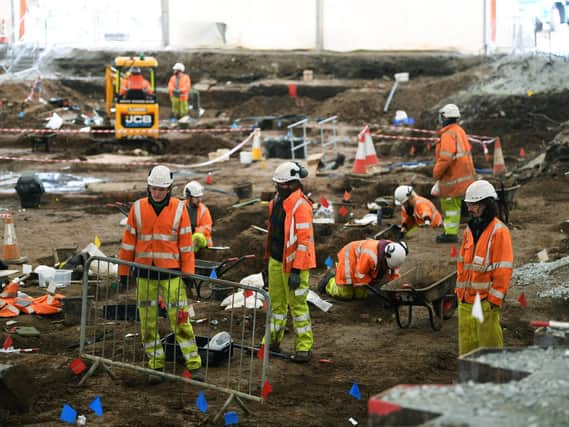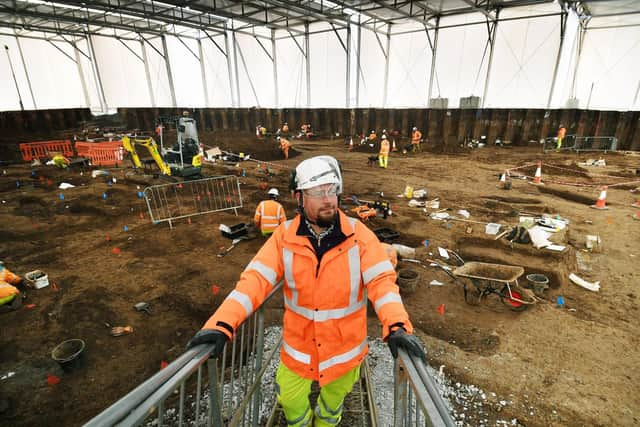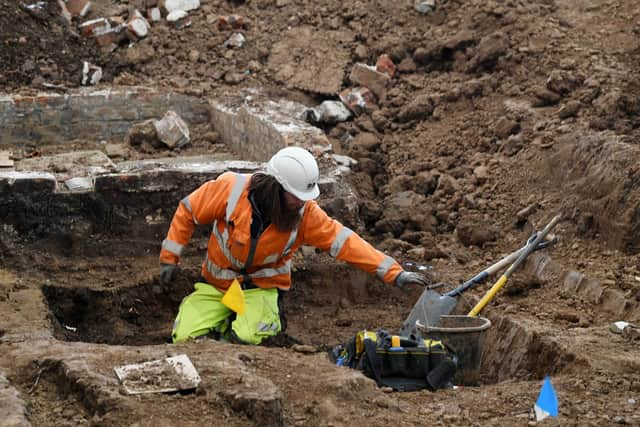Latest finds from Trinity burial ground archaeological dig reveals victim of 1837 docklands disaster


Archaeologists working on an excavation taking place as part of Highways England’s £355m A63 Castle Street upgrade discovered the remains of a man in his 30s, who had suffered blast injuries, and is thought to have been a passenger on the ill-fated Union steam packet.
The vessel was about to embark from the Humber Basin for her home port of Gainsborough when just after 6am on 7 June 1837, it was ripped apart by an explosion.
Advertisement
Hide AdAdvertisement
Hide AdEyewitnesses recounted a tremendous explosion, which sent the ship’s chimney spinning into the air before landing in front of Minerva Terrace. One man’s body was found was sixty yards away on the roof of a property and debris was blown as far as Humber Street.


Another possible victim of the explosion, which claimed as at least 23 lives, was also discovered in the dig.
Stephen Rowland, project manager for Oxford Archaeology North, said both sets of remains showed extensive fracturing, with badly broken limbs, and one with a cruciform-shaped impression on his knee, caused by flying debris.
Among the victims were youngsters like engine boy William Bland, 14, and stoker James Goddard, 16. Two brothers also died, William Hutchinson, 18 and his brother Arthur, 21.
Advertisement
Hide AdAdvertisement
Hide AdA headstone found during the dig, was dedicated to 47-year-old Rebecca Cleg of Manchester, whose body was recovered from the water a few weeks later after the tragedy.


She had drowned alongside many others who were in the ship’s cabin, the vessel sinking soon afterwards. But her husband had run on deck and was saved.
However archaeologists were unable to discover the whereabouts of her remains.
Mr Rowland said the findings from the dig on the Trinity burial ground corroborated the injuries suffered by the passengers and described in graphic detail in newspapers at the time, adding: “It is rare to find direct evidence of a historical incident, particularly one that was so infamous in Hull.”
Advertisement
Hide AdAdvertisement
Hide AdThe disaster was only eclipsed when the R.38/ZR-2 airship exploded on a test flight and crashed into the Humber on August 24, 1921, killing 44 of its 49-strong British and American crew in front of thousands of onlookers.
The landmark tents by the A63, which have been home to the largest-ever scientific excavation of a post-medieval burial ground in northern England, are now coming down.
The dig has yielded a wealth of information about the city’s past. In all 9,500 sets of remains have been exhumed and will be reburied onsite.
Archaeologists will continue to work over the coming weeks on an 18th-century jail which stood at the north-east corner and was influenced by the work of prison reformers John Howard and Elizabeth Fry, who promoted the need for better conditions, productive labour and religious instruction.
A63 upgrade work
Advertisement
Hide AdAdvertisement
Hide AdThe A63 will be closed between Daltry Street flyover and Roger Millward Way from Monday August 16 for up to 14 weekday nights as the Porter Street pedestrian crossing is removed and a temporary one is installed. Alterations to the roadworks layout will also be carried at Mytongate junction.
The closures will be in place Monday to Friday between 8pm and 6am, apart from the bank holiday weekend, when work will finish on Thursday evening and restart the following Tuesday evening. The exit on to the A63 westbound carriageway from Commercial Road is closed and will be until the end of October.
Comment Guidelines
National World encourages reader discussion on our stories. User feedback, insights and back-and-forth exchanges add a rich layer of context to reporting. Please review our Community Guidelines before commenting.